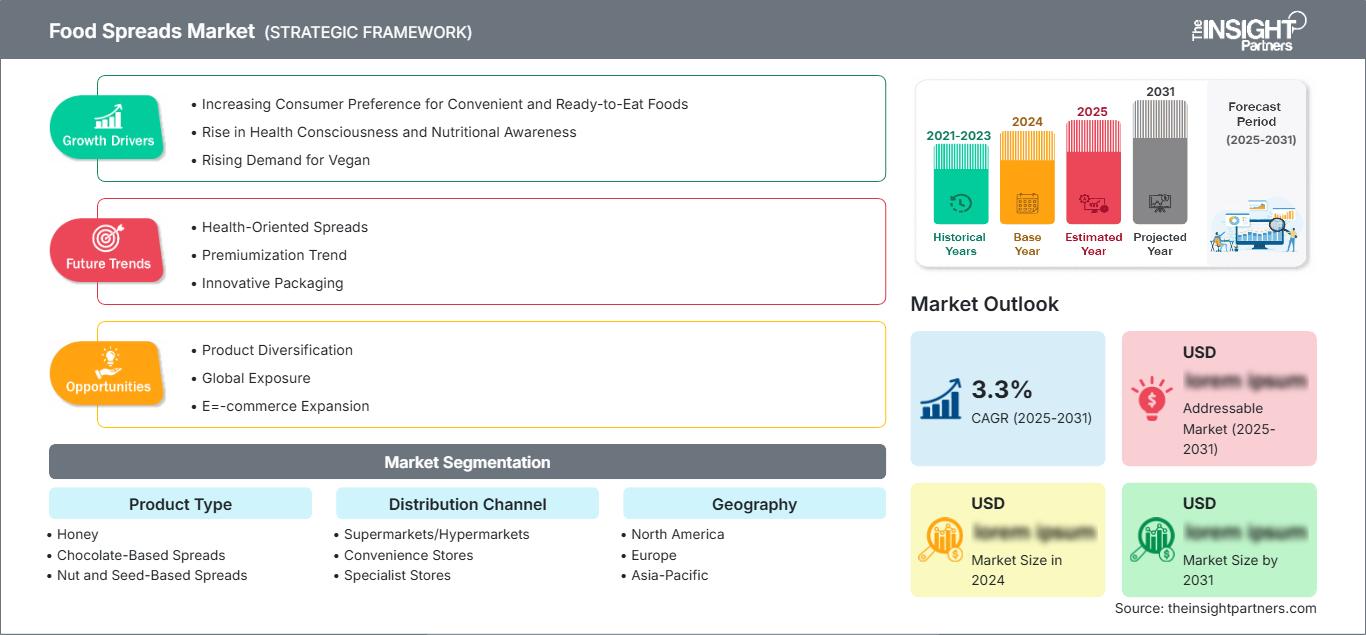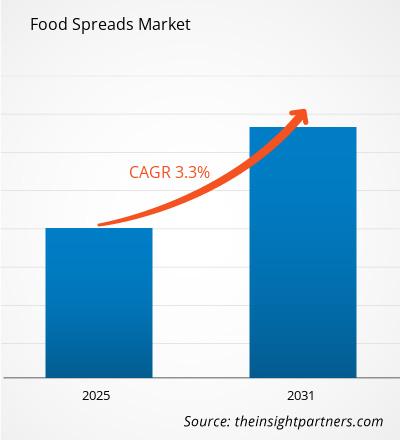Si prevede che il mercato degli spalmabili alimentari registrerà un CAGR del 3,3% dal 2025 al 2031, con una dimensione del mercato in espansione da XX milioni di dollari nel 2024 a XX milioni di dollari entro il 2031.
Il rapporto sul mercato degli spalmabili alimentari comprende l'analisi per tipologia di prodotto (miele, spalmabili a base di cioccolato, spalmabili a base di noci e semi, spalmabili a base di frutta, altri); canale di distribuzione (supermercati/ipermercati, minimarket, negozi specializzati, negozi al dettaglio online, altri) e area geografica (Nord America, Europa, Asia-Pacifico e Sud e Centro America). L'analisi globale è ulteriormente suddivisa a livello regionale e per i principali paesi. Il rapporto offre il valore in USD per l'analisi e i segmenti sopra indicati.
Scopo del rapporto
Il rapporto sul mercato degli spalmabili alimentari di The Insight Partners mira a descrivere il panorama attuale e la crescita futura, i principali fattori trainanti, le sfide e le opportunità. Ciò fornirà spunti a vari stakeholder aziendali, come:
- Fornitori/produttori di tecnologia: per comprendere le dinamiche di mercato in evoluzione e conoscere le potenziali opportunità di crescita, consentendo loro di prendere decisioni strategiche informate.
- Investitori: per condurre un'analisi completa delle tendenze in merito al tasso di crescita del mercato, alle proiezioni finanziarie del mercato e alle opportunità esistenti lungo la catena del valore.
- Organismi di regolamentazione: per regolamentare le politiche e le attività di controllo nel mercato con l'obiettivo di ridurre al minimo gli abusi, preservare la fiducia degli investitori e sostenere l'integrità e la stabilità del mercato.
Segmentazione del mercato delle creme spalmabili alimentari Tipo di prodotto
- Miele
- Creme spalmabili a base di cioccolato
- Creme spalmabili a base di noci e semi
- Creme spalmabili a base di frutta
- Altri
Canale di distribuzione
- Supermercati/Ipermercati
- Negozi di alimentari
- Negozi specializzati
- Negozi al dettaglio online
Potrai personalizzare gratuitamente qualsiasi rapporto, comprese parti di questo rapporto, o analisi a livello di paese, pacchetto dati Excel, oltre a usufruire di grandi offerte e sconti per start-up e università
Mercato degli spalmabili alimentari: Approfondimenti strategici

-
Ottieni le principali tendenze chiave del mercato di questo rapporto.Questo campione GRATUITO includerà l'analisi dei dati, che vanno dalle tendenze di mercato alle stime e alle previsioni.
Fattori della crescita del mercato delle creme spalmabili
- Crescente preferenza dei consumatori per alimenti comodi e pronti al consumo: la crescente importanza della colazione nella routine quotidiana aumenta la domanda di creme spalmabili come burro e marmellate, secondo i report di mercato. Questa tendenza determina una sostanziale crescita del mercato a livello globale.
- Aumento della consapevolezza sanitaria e nutrizionale: l'introduzione di creme spalmabili biologiche, a basso contenuto di zucchero e arricchite soddisfa i consumatori attenti alla salute, migliorando la competitività del mercato. Le analisi di mercato riflettono queste mutevoli preferenze dei consumatori.
- Crescente domanda di prodotti vegani: la domanda di creme spalmabili vegane, come quelle a base di mandorle e avocado, contribuisce alla crescita delle dimensioni del mercato. L'analisi competitiva rivela un'attenzione all'innovazione basata sulle piante.
Tendenze future del mercato delle creme spalmabili alimentari
- Creme spalmabili salutari: le creme spalmabili a base di frutta secca e a basso contenuto di zucchero stanno dominando, cambiando così le dinamiche del mercato poiché i consumatori richiedono opzioni funzionali e naturali.
- Tendenza alla premiumizzazione: le creme spalmabili di fascia alta con sapori esotici e certificazioni biologiche sono strategie di mercato di nicchia.
- Confezionamento innovativo: design pratici, ecologici e richiudibili attraggono i consumatori moderni e aumentano la differenziazione del marchio.
Opportunità di mercato delle creme spalmabili alimentari
- Diversificazione dei prodotti: poiché i consumatori richiedono alternative più sane al burro e alle creme spalmabili tradizionali, il mercato delle creme spalmabili alimentari sta assistendo a una crescita delle opzioni a base vegetale, a basso contenuto di zucchero e arricchite di nutrienti. Questa tendenza offre agli operatori del mercato un'importante opportunità di innovazione e di conquistare una quota maggiore dei mercati nordamericani ed europei.
- Esposizione globale: con il crescente interesse per i sapori globali, la domanda di creme spalmabili esotiche e di alta qualità è in aumento. I produttori possono sfruttare questa opportunità di crescita offrendo creme spalmabili uniche e gourmet in aree geografiche emergenti e mercati di nicchia, ottenendo un vantaggio competitivo.
- Espansione dell'e-commerce: una piattaforma di vendita al dettaglio online rimodella il mercato delle creme spalmabili, offrendo un canale per una nuova distribuzione. L'e-commerce offre ai marchi l'opportunità di raggiungere un pubblico più ampio, soprattutto in Nord America e in Europa. La spesa alimentare online sta guadagnando slancio in Nord America e in Europa, offrendo opportunità ai marchi.
Mercato delle creme spalmabili alimentari
Le tendenze regionali e i fattori che influenzano il mercato degli spalmabili alimentari durante il periodo di previsione sono stati ampiamente spiegati dagli analisti di The Insight Partners. Questa sezione analizza anche i segmenti e la geografia del mercato degli spalmabili alimentari in Nord America, Europa, Asia-Pacifico, Medio Oriente e Africa, America meridionale e centrale.
Ambito del rapporto sul mercato degli spalmabili alimentari
| Attributo del rapporto | Dettagli |
|---|---|
| Dimensioni del mercato in 2024 | US$ XX million |
| Dimensioni del mercato per 2031 | US$ XX Million |
| CAGR globale (2025 - 2031) | 3.3% |
| Dati storici | 2021-2023 |
| Periodo di previsione | 2025-2031 |
| Segmenti coperti |
By Tipo di prodotto
|
| Regioni e paesi coperti |
Nord America
|
| Leader di mercato e profili aziendali chiave |
|
Densità degli attori del mercato degli spread alimentari: comprendere il suo impatto sulle dinamiche aziendali
Il mercato delle creme spalmabili alimentari è in rapida crescita, trainato dalla crescente domanda da parte dei consumatori finali, dovuta a fattori quali l'evoluzione delle preferenze dei consumatori, i progressi tecnologici e una maggiore consapevolezza dei benefici del prodotto. Con l'aumento della domanda, le aziende stanno ampliando la propria offerta, innovando per soddisfare le esigenze dei consumatori e sfruttando le tendenze emergenti, alimentando ulteriormente la crescita del mercato.

- Ottieni il Mercato degli spalmabili alimentari Panoramica dei principali attori chiave
Punti di forza
- Copertura completa: il rapporto analizza in modo esaustivo prodotti, servizi, tipologie e utenti finali del mercato degli spalmabili alimentari, offrendo una panoramica olistica.
- Analisi degli esperti: il rapporto è redatto sulla base della conoscenza approfondita di esperti e analisti del settore.
- Informazioni aggiornate: il rapporto garantisce la pertinenza aziendale grazie alla copertura di informazioni e dati recenti.
- Opzioni di personalizzazione: questo rapporto può essere personalizzato per soddisfare le esigenze specifiche del cliente e adattarsi in modo appropriato alle strategie aziendali.
Il rapporto di ricerca sul mercato degli spalmabili alimentari può quindi aiutare a guidare il percorso di decodificazione e comprensione dello scenario del settore e delle prospettive di crescita. Sebbene possano esserci alcune preoccupazioni valide, i vantaggi complessivi di questo rapporto tendono a superare gli svantaggi.
- Analisi storica (2 anni), anno base, previsione (7 anni) con CAGR
- Analisi PEST e SWOT
- Valore/volume delle dimensioni del mercato - Globale, Regionale, Nazionale
- Industria e panorama competitivo
- Set di dati Excel
Report recenti
Rapporti correlati
Testimonianze
Motivo dell'acquisto
- Processo decisionale informato
- Comprensione delle dinamiche di mercato
- Analisi competitiva
- Analisi dei clienti
- Previsioni di mercato
- Mitigazione del rischio
- Pianificazione strategica
- Giustificazione degli investimenti
- Identificazione dei mercati emergenti
- Miglioramento delle strategie di marketing
- Aumento dell'efficienza operativa
- Allineamento alle tendenze normative






















 Ottieni un campione gratuito per - Mercato degli spalmabili alimentari
Ottieni un campione gratuito per - Mercato degli spalmabili alimentari